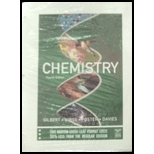
Concept explainers
(a)
Interpretation: The electronic configuration and the stability of
Concept introduction: When two atomic orbitals come close to each other they lose their identity and form new pair of orbitals knows as molecular orbitals. Among the two molecular orbitals formed one has energy lower than the atomic orbitals is known as bonding molecular orbital and the other has energy higher than the atomic orbitals and is known as antibonding molecular orbital.
To determine: The electronic configuration of
(a)
Answer to Problem 9.92QP
The electronic configuration of
Explanation of Solution
Explanation
Helium has two valence electrons.
The total number of valence electrons in
According to the molecular orbital theory the electronic configuration of
Neon has eight valence electrons.
The total number of valence electrons in
According to the molecular orbital theory the electronic configuration of
(b)
To determine: The stability of the molecular ions formed by removing one electron from
(b)
Answer to Problem 9.92QP
The molecular ions
Explanation of Solution
Explanation
On removing an electron from
The total number of valence electrons in
According to the molecular orbital theory the electronic configuration of
The bond order of
The bond order of
On removing an electron from
The total number of valence electrons in
According to the molecular orbital theory the electronic configuration of
The bond order of
The bond order of
The stability of an ion or a molecule is directly proportional to its bond order.
Both
The molecules
Therefore, the molecular ions
The stability of an ion or a molecule is directly proportional to its bond order.
Want to see more full solutions like this?
Chapter 9 Solutions
Chemistry
 ChemistryChemistryISBN:9781305957404Author:Steven S. Zumdahl, Susan A. Zumdahl, Donald J. DeCostePublisher:Cengage Learning
ChemistryChemistryISBN:9781305957404Author:Steven S. Zumdahl, Susan A. Zumdahl, Donald J. DeCostePublisher:Cengage Learning ChemistryChemistryISBN:9781259911156Author:Raymond Chang Dr., Jason Overby ProfessorPublisher:McGraw-Hill Education
ChemistryChemistryISBN:9781259911156Author:Raymond Chang Dr., Jason Overby ProfessorPublisher:McGraw-Hill Education Principles of Instrumental AnalysisChemistryISBN:9781305577213Author:Douglas A. Skoog, F. James Holler, Stanley R. CrouchPublisher:Cengage Learning
Principles of Instrumental AnalysisChemistryISBN:9781305577213Author:Douglas A. Skoog, F. James Holler, Stanley R. CrouchPublisher:Cengage Learning Organic ChemistryChemistryISBN:9780078021558Author:Janice Gorzynski Smith Dr.Publisher:McGraw-Hill Education
Organic ChemistryChemistryISBN:9780078021558Author:Janice Gorzynski Smith Dr.Publisher:McGraw-Hill Education Chemistry: Principles and ReactionsChemistryISBN:9781305079373Author:William L. Masterton, Cecile N. HurleyPublisher:Cengage Learning
Chemistry: Principles and ReactionsChemistryISBN:9781305079373Author:William L. Masterton, Cecile N. HurleyPublisher:Cengage Learning Elementary Principles of Chemical Processes, Bind...ChemistryISBN:9781118431221Author:Richard M. Felder, Ronald W. Rousseau, Lisa G. BullardPublisher:WILEY
Elementary Principles of Chemical Processes, Bind...ChemistryISBN:9781118431221Author:Richard M. Felder, Ronald W. Rousseau, Lisa G. BullardPublisher:WILEY





